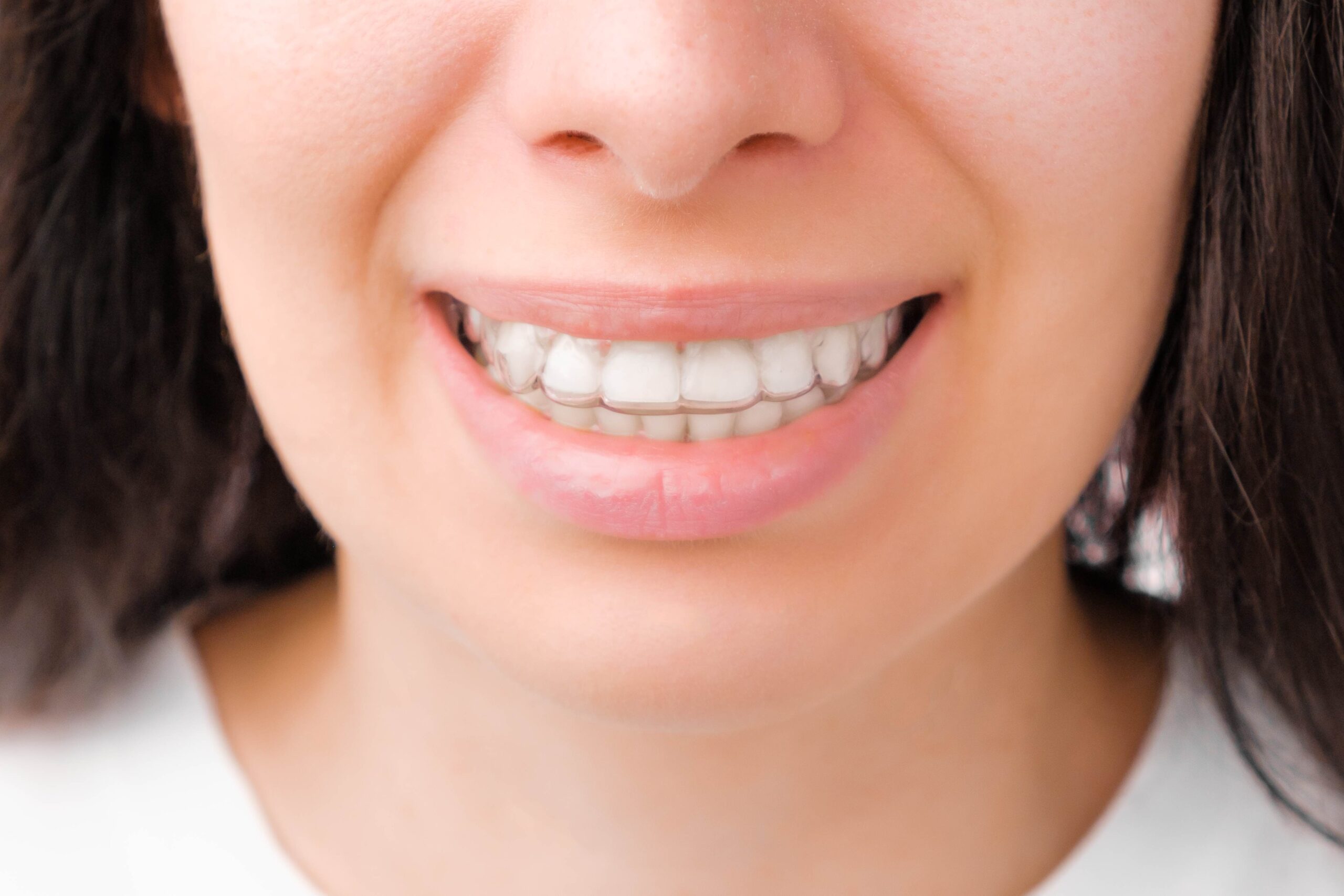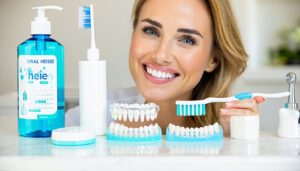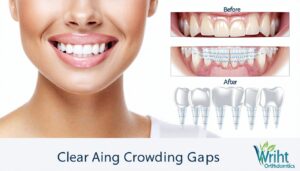Clear Aligners for Overbite
When looking for solutions to correct an overbite, clear aligners such as Invisalign offer a modern, convenient, and subtle approach. These removable aligners are custom-made to gradually move the teeth into the desired position, providing a viable and effective solution for patients. Moreover, they have gained immense popularity in orthodontic care due to their discreet nature and effectiveness source.
Benefits of Invisalign
Invisalign treatment for overbite not only addresses overbite problems but also improves the overall alignment of the teeth. This treatment has the capability to correct an excessive or large overbite, also known as a deep bite Invisalign.
Compared to traditional braces, Invisalign offers several advantages. These clear aligners are virtually invisible, providing similar benefits of traditional braces without the visibility of metal brackets and wires. Invisalign treatment also offers effective gradual teeth movement with less pain, flexibility to easily remove the aligners, fewer doctor visits, an individually mapped digital treatment plan indicating the duration of treatment, and improved oral health due to the ability to remove aligners for brushing and flossing Invisalign.
Treatment Duration
The treatment duration for overbite correction using Invisalign can range from 12 to 18 months, depending on the severity of the overbite. Some cases may take up to 2 years for complete overbite adjustment source. However, on average, aligning an overbite with clear aligners takes about 9 to 12 months Northwest Prosthodontics.
It’s important to note that clear aligners work by gradually applying pressure to move teeth to the proper alignment. To ensure effective results, they should be worn for at least 22 hours daily and switched to a new pair approximately every two weeks Northwest Prosthodontics. Failing to follow these instructions can cause delays or prevent desired results.
Overall, clear aligners like Invisalign are an effective solution to correct overbites, offering a host of advantages over traditional metal braces. However, their suitability for severe overbites caused by skeletal jaw problems may be limited, and professional consultation is advised to make the best choice.
Correcting Overbite with Invisalign
Invisalign treatment for overbite correction has gained popularity due to its discreet, comfortable, and practical approach. Suitable for correcting excessive or large overbites, also known as deep bites, Invisalign clear aligners offer a customized solution that can be tailored to the individual’s needs.
Customized Treatment Plans
Each Invisalign treatment is unique, with the aligners customized to fit the patient’s teeth perfectly. The treatment plan is digitally mapped out, presenting a clear timeline of the expected duration of treatment, which typically ranges from 12 to 24 months depending on the individual case source.
Invisalign treatment offers gradual and effective teeth movement with less pain, fewer doctor visits compared to traditional braces, and improved oral health. This is due to the ability to remove aligners for brushing and flossing, thereby maintaining good oral hygiene throughout the treatment source.
However, it’s important to note that clear aligners like Invisalign and SureSmile are effective for treating mild to moderate overbites. They may not be suitable for severe overbites caused by skeletal jaw problems source.
Aligner Maintenance
Maintaining the condition of Invisalign aligners is crucial to the success of the treatment. Patients are advised to wear the aligners for 20 to 22 hours a day. Care needs to be taken to avoid warping the plastic, which can affect treatment progress and effectiveness source.
Key maintenance tips include cleaning the aligners regularly, avoiding hot drinks while wearing the aligners to prevent warping, and storing the aligners in a safe place when not in use.
By following the individualized treatment plan and maintaining the aligners, patients can make the most of their Invisalign treatment and achieve a beautiful smile free from overbite. The journey to correcting an overbite with clear aligners can indeed be a transformative and empowering experience.
Invisalign Effectiveness
When considering clear aligners for overbite correction, understanding the effectiveness of the treatment is crucial. Here, we focus on Invisalign, a widely recognized brand in the clear aligner industry.
Research Findings
Research into the effectiveness of Invisalign is limited; however, available studies do shed light on its capabilities. A 2017 study suggests that Invisalign may be more useful in aligning a person’s arches than addressing severe bite problems (Healthline). That being said, the same research indicates that Invisalign can successfully correct mild to moderate overbites.
According to Invisalign, the treatment has been successful in delivering satisfied smiles for overbite cases, among millions of other cases worldwide. On the other hand, patients with severe overbites and other teeth misalignments may not be suitable candidates for clear aligners; in such cases, traditional metal or ceramic braces could be recommended instead (Northwest Prosthodontics).
Tooth Movement Rate
Interestingly, a study involving 30 volunteers found that the rate of tooth movement with Invisalign may increase slightly between ages 35 to 50, potentially making it more effective for individuals in this age group.
The duration of the treatment depends on the severity of the condition. Current data, including research from 2017, indicates that the average treatment duration for overbites with Invisalign is estimated to be between 6 months and 2 years, whereas traditional braces are worn on average for 1 to 3 years.
However, it’s important to note that not following the instructions on wearing aligners can cause delays or prevent the desired results. Hence, commitment to the treatment plan is essential for successful alignment.
In conclusion, while Invisalign can be effective for mild to moderate overbite correction, it may not be suitable for severe cases. The age of the patient and their commitment to the treatment plan also play significant roles in the success of the treatment.
Overbite Correction in Adults
Overbite correction is a common concern for many adults. While orthodontic treatment is often associated with adolescents, adults too can achieve a beautiful smile with the right treatment plan. In this section, we will explore orthodontic solutions for overbite correction in adults and discuss the role of hereditary factors.
Orthodontic Solutions
Overbites can be corrected in adults with the help of orthodontics, which may last for two or more years depending on the severity of the overbite. Although treating overbites is typically easier in children, correction for adults is quite common and has become more readily available over time (Medland Orthodontics).
The right treatment option depends on several factors including the severity of the overbite, budget, and duration of treatment. Among the various solutions available, Invisalign clear aligners have proven to be an effective option for overbite correction. These aligners are capable of correcting an excessive or large overbite, also known as a deep bite. Treatment times can vary from about 12 to 24 months depending on the individual case (Invisalign).
| Orthodontic Solutions | Duration |
|---|---|
| Traditional Braces | 2 Years + |
| Invisalign | 12 – 24 months |
Hereditary Factors
Overbites can result from a variety of factors, including hereditary elements, early childhood habits like thumb sucking, or issues with jaw development. Overbites can be either dental or skeletal in nature (Medland Orthodontics).
Dental overbites, where the teeth are the problem and not the jaw, can often be corrected without the need for surgery. Skeletal overbites, on the other hand, where the jaw is also misaligned, may require surgical solutions for realignment in addition to orthodontic treatment.
Regardless of the cause, it’s important to remember that overbite correction in adults is possible with the right orthodontic treatment. Invisalign treatment has been successful in delivering satisfied smiles for overbite cases, among millions of other cases worldwide, showcasing the effectiveness of Invisalign in treating overbites (Invisalign).
Invisalign vs. Traditional Braces
When deciding between Invisalign and traditional braces for overbite correction, it’s important to consider aspects such as cost, treatment duration, and level of pain and discomfort. Both options have their pros and cons, and the best choice will depend on individual needs and circumstances.
Cost and Treatment Duration
The cost of braces in the United States ranges from $3,000 to $7,000 on average, with Invisalign being comparable or slightly more expensive. Factors influencing the cost include location, treatment duration, complexity of dental concerns, and the orthodontist chosen. Dental insurance plans may cover part of orthodontic treatments, with braces being more likely to be covered than Invisalign.
In terms of treatment duration, Invisalign is often utilized for treating mild to moderate dental concerns, with the average duration of treatment ranging from 12 to 18 months. In some cases, it may require only six months. In comparison, fixed braces typically take one to two years to achieve results, depending on individual factors (Verywell Health).
| Factor | Traditional Braces | Invisalign |
|---|---|---|
| Cost | Comparable or higher | |
| Treatment Duration | 1 – 2 years | 6 months – 18 months |
Pain and Discomfort Comparison
When it comes to comfort, research indicates that individuals with traditional braces tend to experience more pain and discomfort, particularly in the initial weeks of treatment and during adjustments, compared to those using Invisalign. Patients using Invisalign may face challenges like excessive salivation and a lisp during the initial days of treatment. However, these are temporary and often resolve as the individual acclimates to the aligners (Verywell Health).
Moreover, to avoid complications such as tooth decay, individuals wearing braces need to refrain from consuming certain foods that can stick to or damage the brackets, including hard and sticky foods. In contrast, Invisalign offers the advantage of being removable during eating and drinking, although it is essential to brush and floss before reinserting them to prevent tooth decay.
| Factor | Traditional Braces | Invisalign |
|---|---|---|
| Pain and Discomfort | More common | Less common, temporary issues |
| Eating Restrictions | Yes | No, but need to clean before reinserting |
Choosing the best method for correcting an overbite comes down to personal preference and the complexity of the dental issue. Both traditional braces and clear aligners have their benefits and drawbacks, and a consultation with an orthodontist can provide more personalized advice.
Oral Health with Aligners
Maintaining oral health while undergoing orthodontic treatment is crucial. With clear aligners for overbite correction, one can expect fewer oral health issues compared to traditional braces, provided proper care is taken.
Cavities and Gum Problems
Unlike traditional braces, clear aligners like Invisalign have been associated with fewer cavities, reduced tooth decay, and lesser gum problems (Verywell Health). This is because clear aligners can be easily removed, allowing for thorough brushing and flossing. This helps to prevent plaque buildup and cavities, promoting overall oral health.
Moreover, the smooth plastic surface of clear aligners is less likely to irritate or damage the gums and soft tissues in the mouth. This reduces the risk of developing gum problems such as gingivitis and periodontitis, which are often associated with traditional braces.
However, it’s important to remember that while clear aligners can help to maintain good oral health, they are not a substitute for regular dental check-ups and professional cleanings.
Dental Care and Hygiene
Proper care of clear aligners is essential to prevent bacteria and calcium buildup, which can lead to oral health problems. According to Invisalign, this involves washing the aligners with Invisalign’s cleaning solution after every meal.
In addition to cleaning the aligners, maintaining good oral hygiene is equally important. This includes regular brushing and flossing, as well as using a mouthwash to keep the mouth fresh and clean. Furthermore, aligners should be removed when eating and drinking anything other than water to prevent staining and damage.
By following these oral care tips, individuals can ensure that their clear aligners remain clean, odor-free, and effective in correcting their overbite. This, in turn, helps to maintain overall oral health and hygiene, leading to a healthier, more beautiful smile.






